
Dell's XPS 12 is the smoothest convertible Ultrabook we've seen.
For better or worse, Windows 8 has prompted some of the most adventuresome PC designs we've seen in years. Many of these are trying to capitalize on both of the new operating systems faces—the new touch-oriented Start screen and its apps on one, and the classic desktop environment on the other.
Most of these computers are either good laptops but questionable tablets (the Lenovo IdeaPad Yoga 13) or good tablets but mediocre laptops (the Microsoft Surface and many of the other dockable tablets). The need to balance factors like size, weight, battery life, and performance (and also, I suppose, the laws of physics) have prevented any one machine from being really good at both tasks, though several that we've seen have come close.
Dell's XPS 12, which if you'll recall is the one with the touchscreen that flips on its axis, is one of the close ones. It may well hit that convertible sweet spot for many. It's still a bit too big and a bit too heavy to be a "tablet" in the post-iPad sense of the word, but it's perfectly usable as a tablet in short bursts. The best part is that even if you don't particularly care about the tablet functionality, the XPS 12 is still a pretty great Ultrabook.
Body and build quality
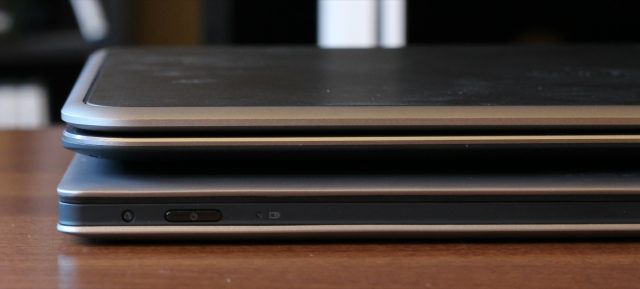
Despite its 12.5-inch screen, the XPS 12 is similar in thickness and weight to larger 13-inch Ultrabooks like the Lenovo IdeaPad Yoga (bottom).
| SPECS AT A GLANCE: DELL XPS 12 | |
|---|---|
| SCREEN | 1920×1080 at 12.5" (176 ppi) |
| OS | Windows 8 64-bit |
| CPU | 1.7GHz Intel Core i5-3317U (Turbo up to 2.6GHz) |
| RAM | 4GB 1600MHz DDR3 (non-upgradeable, 8GB version available) |
| GPU | Intel HD Graphics 4000 (integrated) |
| HDD | 128GB Samsung 830 solid-state drive |
| NETWORKING | Dual-band 802.11n, Bluetooth 3.0 |
| PORTS | 2x USB 3.0, mini DisplayPort, headphones |
| SIZE | 12.48" × 8.46" × 0.59-0.79" (317 × 215 × 15-20 mm) |
| WEIGHT | 3.35 lbs (1.52 kg) |
| BATTERY | 6-cell 47WHr Li-ion |
| WARRANTY | 1 year |
| STARTING PRICE | $1199.99 (price as reviewed) |
| OTHER PERKS | TPM, webcam, volume rocker, screen orientation lock button, battery indicator |
The XPS 12’s screen splits the difference between the more common 11-inch and 13-inch screen sizes, but in physical size and weight it feels more like a 13-inch laptop—the screen’s flipping mechanism adds a bit of extra thickness and weight to the laptop while also adding thickness to the bezel surrounding the touchscreen. At 3.35 pounds it’s still relatively light and its slightly tapered body isn’t what we’d call chunky—it’s 0.79” at its thickest point and 0.59” at its thinnest—but it’s not class-leading in either respect.
If you’re familiar with Dell’s more recent XPS laptops, particularly the XPS 13, then the styling of the laptop will look familiar. The laptop is mostly made of thick, sturdy plastic with an aluminum trim, and Dell makes liberal use of a slightly rubberized texture in the wrist rest, the lid, and the bottom of the computer. The plastic on the lid and underside of the laptop have a very subtle sort of checkerboard pattern that looks quite fetching, though they both attract fingerprints and dust like nobody's business.
Despite its primarily plastic construction, the fit-and-finish of the XPS 12 is exemplary. There’s not a creak or a flex to be found anywhere. Even the touchscreen and its flipping mechanism, which could easily feel a bit flimsy given the number of small moving parts involved, feels very sturdy. This is a good sign because that flippable screen is one of the XPS 12’s main selling points.
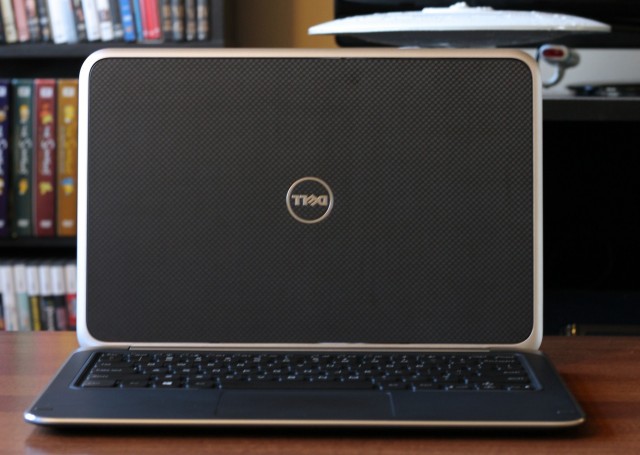
The laptop's lid (shown here flipped) uses a slightly rubberized checkerboard texture.
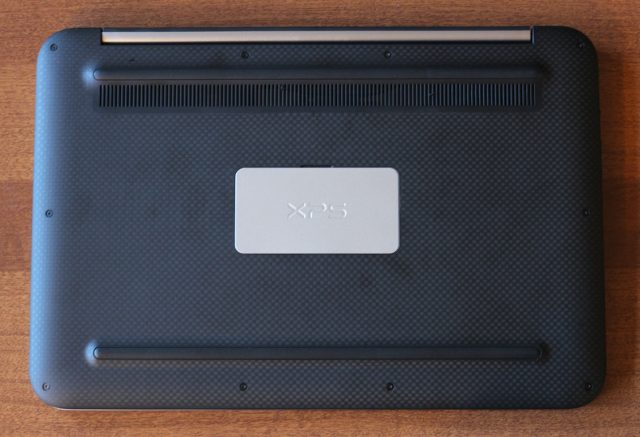
The bottom of the laptop uses the same texture, which is slightly grippy and easy to hold when in tablet mode.
The screen
First, a few words about the display itself—I can’t say how happy it makes me to do yet another PC review where I don’t have to harp on about a washed out, low-quality, low-contrast, low-resolution LCD. The sole complaint that can be leveled toward XPS 12’s 1080p IPS panel is that, at 12 inches, UI elements can sometimes be a bit small. Windows 8’s scaling helps take the edge off; the Start screen and the Windows Store apps are mostly built from the ground up to scale well. Out of the box, the Windows desktop is also set to render graphics at 125 percent of their normal size—enough to take the edge off for those without the best eyes, but not so much that UI elements render poorly (as they sometimes can at “Retina”-style 200 percent scaling).
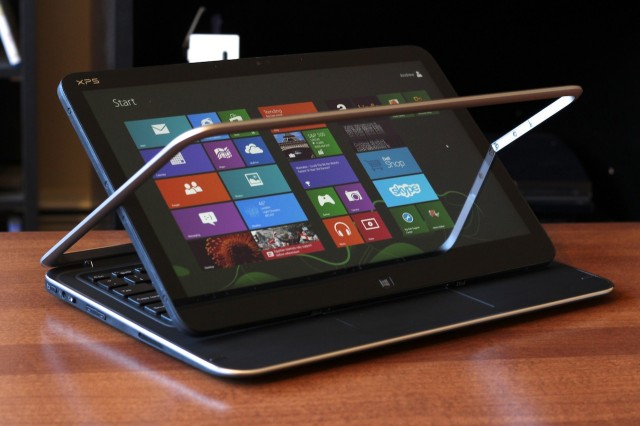
The XPS 12's flippable touchscreen is its claim to fame.
That excellent screen is placed front-and-center when converting the laptop into a tablet, which is accomplished by pushing on the back of the screen in the direction of the keyboard to flip it over. The screen will lock into place once flipped, and at that point the lid can be closed all the way to complete the “tablet mode” transformation. The base of the laptop can also serve as a built-in adjustable stand for the screen—moving the screen out of its standard “laptop” position immediately disables the keyboard and trackpad, preventing accidental input.
Usually, the magnets and small plastic latches that hold the screen in place did a decent job of preventing accidental flips, though I did occasionally find myself pressing too hard and flipping the screen on accident. Some sort of switch that would force the screen to stay in place would be a nice touch here, but in general the flipping mechanism works well.
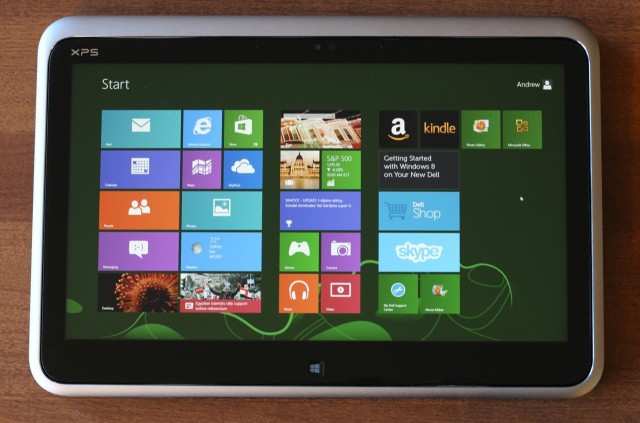
The XPS isn't a perfect tablet, but it's usable, and that's a step up from most convertibles.
Even once the screen is flipped and the laptop closed, the XPS 12 is still too heavy to be an iPad or Nexus 10 competitor—it’s between two and three times heavier than either tablet. Small adjustments make it more usable than its Windows-based competition, though; unlike the IdeaPad Yoga, there’s no exposed keyboard on the back of the tablet to make you nervous about holding it or putting it down on a flat surface. The grippy, slightly rubberized texture on the back of the screen makes it a bit easier to hold, and its slightly reduced width and weight compared to some 13-inch convertibles make it a bit easier to balance in one or both hands.
This isn’t the magical do-anything device that will replace both your current tablet and your current laptop, but it’s more than capable of doing tablet duties on a plane ride or in other places where a full-fledged laptop might be difficult to unfold and use. It also avoids the bulky keyboard docks used by the systems that are trying harder to be, for lack of a better phrase, more tablet-y tablets.
Keyboard and trackpad
Thankfully, this functional-if-not-exceptional tablet functionality in no way affects the XPS 12’s suitability as a laptop—if you’ve been eyeing an XPS 13, you should very strongly consider dropping the extra $200 and going for one of these instead. The screen is one thing that makes this a pleasant laptop to use, but Dell also manages to get the keyboard right.
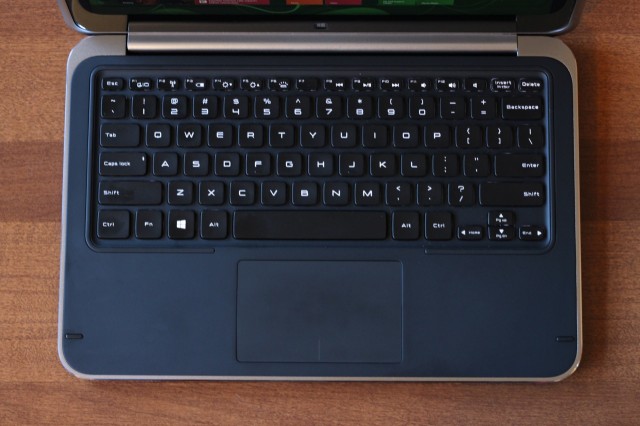
The XPS 12's keyboard is excellent.
After reviewing the strange keyboard on the Acer Aspire S7, just seeing the XPS 12’s keyboard layout was a relief. There’s nothing strange here—it’s a pretty standard keyboard layout save for the half-height arrow and function keys. It’s more or less the same layout Dell uses across all of its XPS laptops, so if you’re comfortable with those keyboards, you’ll be comfortable with this one.
The XPS 12’s keyboard isn’t just good compared to bad keyboards like the one in the S7; it’s a very good keyboard in its own right, and it’s easily as good as the satisfying, high-quality chiclet keyboards included in the Asus Zenbook Prime or Apple’s MacBook Air. The keys have good travel and are nice and clicky, there’s no bending or flexing, and the backlight is bright and even. The keyboard is one of the most important things to get right in a laptop and Dell really nails it here.
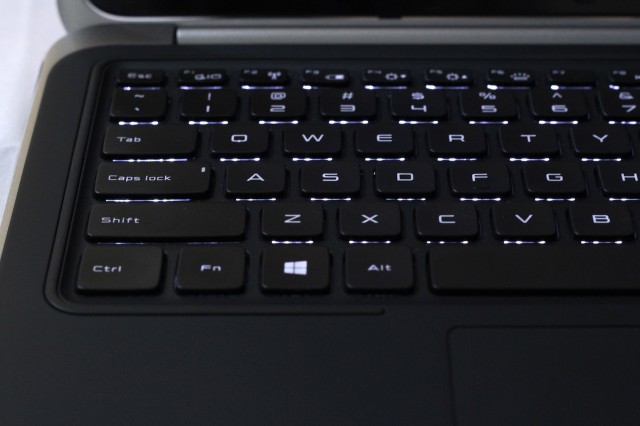
We can't oversell the importance of a good keyboard, and the XPS 12 gets it right.
The trackpad will elicit a slightly more muted reaction, but it’s still good enough for what it is: a multitouch glass version from Cypress that’s very satisfying and clicky, but just a little bit flaky and oversensitive out of the box. This issue is mostly addressable with a driver update and some tweaking in the trackpad’s settings, thankfully. The standard Windows 8 trackpad gestures as well as basic features like two-finger scrolling, tap to click, and pinch to zoom all work as expected.
Ports

On the left, the XPS 12 has a screen orientation lock, headphone jack, power switch, volume rocker, and speaker.

On the right side of the laptop, we've got a power jack, a mini DisplayPort, two USB 3.0 ports, a battery life indicator, and another speaker. An SD card reader is conspicuous in its absence.
Finally, we’ve come to the list of ports and buttons... it’s not a long one. The XPS 12 packs what I would consider to be the bare minimum complement of ports in a laptop like this one: two USB 3.0 ports, a mini DisplayPort, and headphone jack—the only glaring omission is the lack of an SD card reader (which we really like to see included in most high-end laptops these days). Stereo speakers are located on its left and right edges, typical of most laptops. They get pretty loud and don't sound terrible, but there's not much bass to speak of.
A volume rocker, screen orientation lock, and power switch are also stored on the sides of the laptop, primarily to be used when the laptop is in tablet mode. A battery life indicator button is also present. The power switch is a slider rather than a button, which helps to prevent accidental button presses when moving the laptop around. No adapters or dongles are provided in the box, but dongles converting to and from mini DisplayPort and USB 3.0 are plentiful.
Internals, performance, reparability, and battery life
From a performance standpoint, the XPS 12 is pure Ultrabook: it uses low-voltage Ivy Bridge CPUs from Intel, the integrated Intel HD 4000 graphics chip, an SSD (in our case, the tried-and-true 128GB mSATA Samsung 830), and 4GB of RAM (upgradeable to 8GB at purchase; a bit more on that later). Dual-band 802.11n and Bluetooth 3.0 round out the wireless connectivity options and a Trusted Platform Module (TPM) chip, disabled by default in the BIOS, will enable easy drive encryption via BitLocker for those who upgrade the laptop to Windows 8 Pro or Enterprise.
We’ve been over this CPU and GPU combo quite a few times before (in our Zenbook Prime and Acer Timeline M5 reviews, among others), and we won’t reprint that information here. Suffice it to say that the XPS 12 boots quickly, launches programs quickly, and responds to user input quickly, though it isn’t a gaming powerhouse or quad-core workstation.
As in the IdeaPad Yoga, some of the SSD’s capacity is consumed by Dell’s recovery partitions, but these only consume about 14GB of space all told, leaving 104GB available for use. This light footprint may be attributable to the laptop’s overall lack of bloatware—aside from a few pre-installed Dell programs, there’s not nearly as much bad stuff on here as we normally see on new Windows laptops. Even power users can probably start using this one straight out of the box without first blowing away the Windows install.
Our sole complaint about the XPS 12 in day-to-day use is that even when idle, the system fan is definitely audible. Doing anything that requires pushing the hardware at all makes it spin up to a more insistent whine.
As for its reparability, getting into the XPS 12 isn’t difficult. First, take a flathead screwdriver into the divot above the XPS nameplate on the bottom of the computer and gently pry upward. The plate itself is captive, but one Phillips head screw (and the systems service tag) lurk underneath.
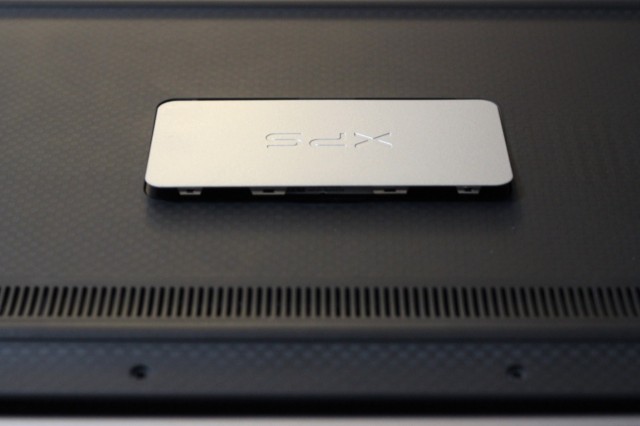
A small access door on the laptop's underside pops open to reveal a Phillips head screw and the computer's service tag.
Next, remove the ten Torx screws from the bottom of the laptop and gently lift it away from the rest of the computer. As is usual for Ultrabooks, the computer’s 47Wh 6128mAh battery is much larger than the actual system board.
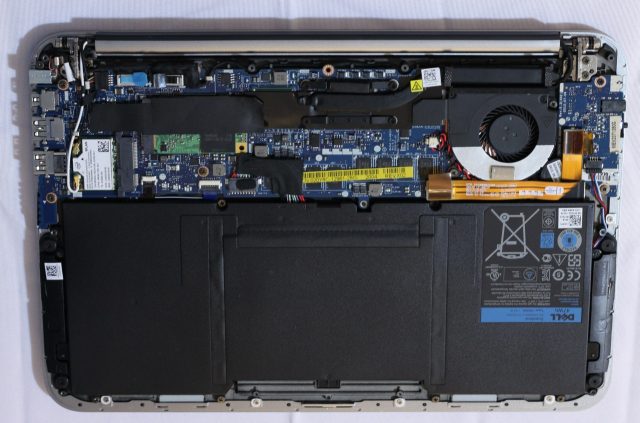
The XPS 12's battery dwarfs its motherboard.
Many of the parts within are replaceable with the aid of Dell’s typically thorough service manual (a PDF of which is available here), including the battery, the SSD, and the wireless card. There is, however, one notable exception: the RAM is soldered to the system board. Unlike some, Dell does offer the option to upgrade the RAM at purchase, but once you’ve bought the computer there’s no way to bump the RAM without also replacing the entire motherboard. Models with 8GB of RAM start at $1399, a $200 increase over the $1199 base model—the $1399 model also includes a slightly faster 1.9GHz Core i7 CPU rather than the 1.7GHz Core i5 in the base configuration.
Battery life
The XPS 12 uses a larger battery than Acer’s Aspire S7, a computer which is held back in large part by its lackluster battery life. With the screen brightness turned all the way up and the automatic brightness sensor disabled (the same conditions under which we tested the S7, the IdeaPad Yoga, and our other recently reviewed laptops), the XPS 12 makes it to almost exactly five hours before needing to be charged while writing, listening to music, and browsing with Chrome.
This is around an hour more than the S7 and an hour less than the Yoga, putting the XPS 12 in toward the low end of the middle of the pack. Your experience may vary based on your own screen brightness preferences and workload, but in general we found the XPS 12’s battery life to be satisfactory but not exceptional.
Conclusions
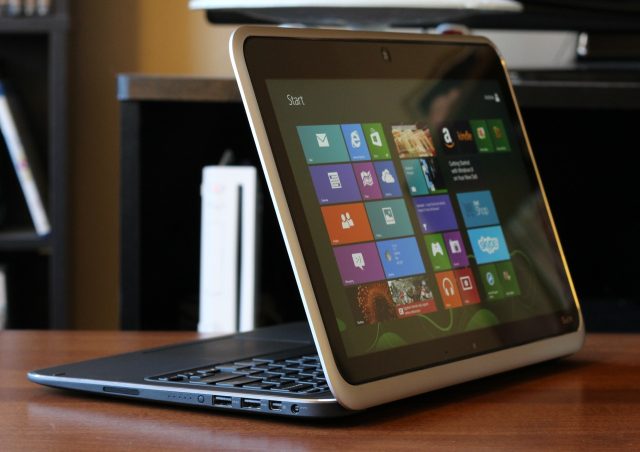
The XPS 12's base can serve as a stand for the touchscreen. The keyboard and trackpad are disabled when the screen is flipped.
So far, our quest for the perfect convertible Windows 8 laptop has left us a bit wanting. Up until now, Lenovo’s IdeaPad Yoga 13 has probably come the closest to satisfying our desires—it has a great screen, good battery life, and a more-or-less decent keyboard if you can look past a bit of mushiness. However, while its unique hinge makes it an intriguing machine, it falls short as a tablet.
The XPS 12 isn’t quite light enough to be a great tablet, at least not in the same way that the iPad and the Nexus 10 are great tablets. Its slightly smaller 12-inch frame and unique screen flipping mechanism do make it a plausible tablet, though (even if it’s a bit chunky). More importantly, this passable tablet functionality does nothing to inhibit its utility as a laptop. It has a great keyboard and good trackpad that aren’t cramped by a bulky sliding mechanism. It’s got a great, colorful high-resolution screen. Its styling is attractive without being derivative. Mediocre battery life is our primary criticism, but if you can look past that the XPS 12 is the most convincing Windows 8 laptop we’ve gotten our hands on.
The good
- Beautiful 1080p IPS touchscreen
- Elegant design and screen flipping mechanism
- Exemplary keyboard, livable touchpad
- Solid construction and good use of textured plastic
- A great alternative to the XPS 13 or another Ultrabook if you’re also in the market for a Sometimes Tablet
- $1199 starting price is competitive with similarly specced non-touch Ultrabooks, some of which also use inferior screens
The bad
- Battery life is only OK
- More fan noise than we’d like
- Slightly heavier than some 13-inch Ultrabooks on the market despite smaller screen size
- Port selection is a little light, and there's no SD card reader.
The ugly
- RAM is soldered to motherboard, though an 8GB upgrade option is at least offered at the time of purchase
No comments:
Post a Comment
Let us know your Thoughts and ideas!
Your comment will be deleted if you
Spam , Adv. Or use of bad language!
Try not to! And thank for visiting and for the comment
Keep visiting and spread and share our post !!
Sharing is a kind way of caring!! Thanks again!